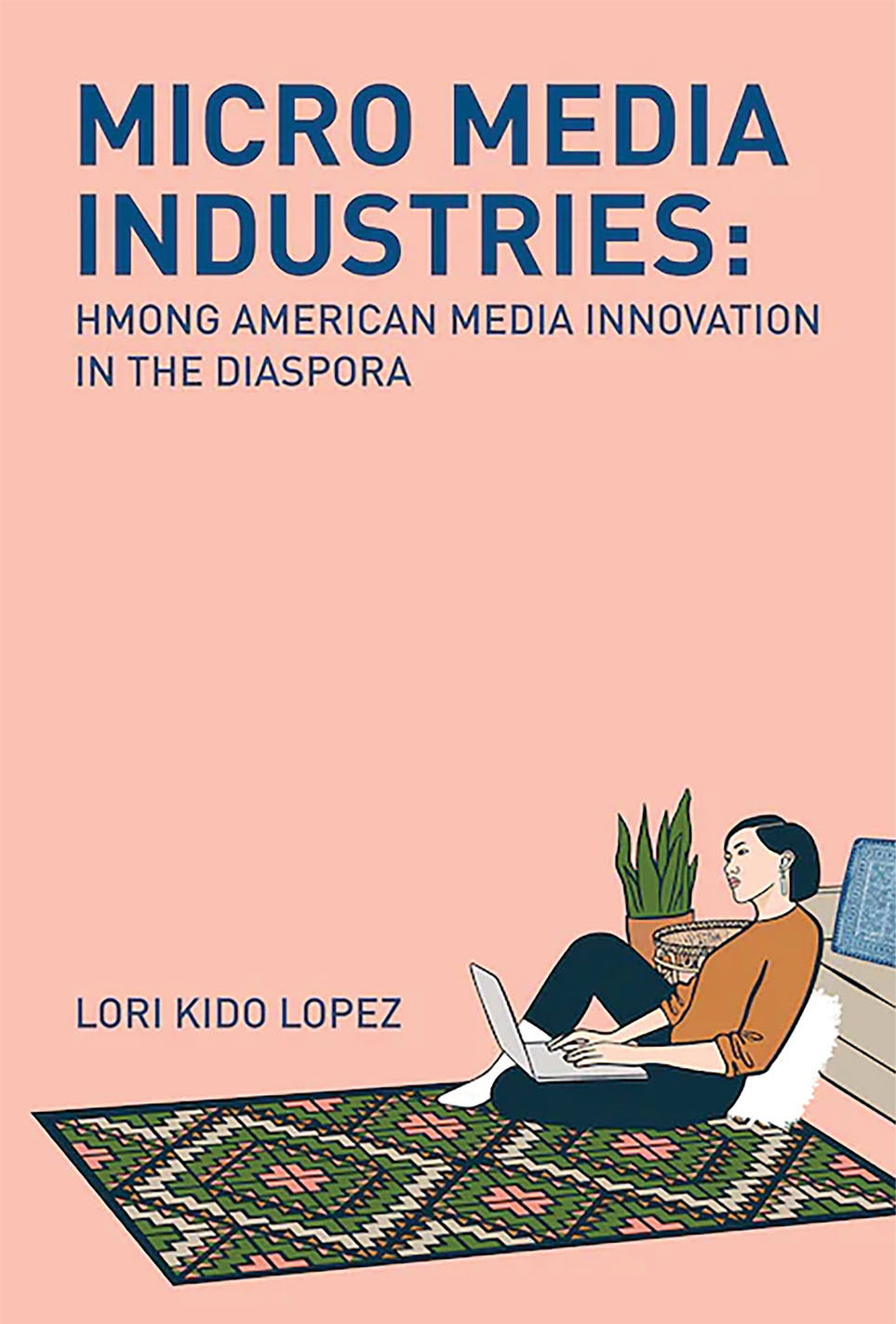In Micro Media Industries: Hmong American Media Innovation in the Diaspora,1 Lori Kido Lopez analyzes small-scale media run by Hmong Americans, including newspapers, radio, television, digital media, and other hybrid forms of media, which are part of what Lopez terms “micro media industries.” Lopez explains how micro media industries have less resources than mainstream or legacy media, are short staffed, and engage in innovative entrepreneurial business practices to survive. Using Hmong American media production as a case study, her book pays attention to the ways that micro media industries empower a geographically dispersed ethnic community and offer avenues for self-representation.
The Hmong global diaspora comprises millions of people from southwestern China, Vietnam, Laos, and Thailand, whose ethnic origins can be traced to the Miao people. Because of this geographic spread as well as erasure from historical accounts, many Hmong people, especially Hmong Americans, negotiate identity in the search for ethnic belonging. The Hmong American community includes hundreds of thousands of people, with highly concentrated groups in California and the Midwestern United States. Lopez makes an important intervention by explaining how Hmong Americans are a “minority within the already minoritized category of Asian Americans” and notes that little research has been done to highlight their thriving micro media platforms and innovative entrepreneurship.2
Lopez argues that micro media industry labor, which is primarily focused on visibility and building community in the global diaspora, disrupts mainstream capitalist models of expansion and conglomeration. Micro media companies may not have the capability or even interest in expanding their small-scale productions, thereby creating some resistance and opportunities for innovation within the larger media ecosystem. However, there are also challenges in this endeavor, because to maintain operations, workers in micro media often engage in labor practices that can cause burnout and emotional stress, ultimately leading to precarity of their business. Therefore, it is important for us to understand how we can support these smaller outlets so they can continue their important civic work for minority communities.
To research Hmong American micro media production, Lopez conducted fifty interviews with Hmong media producers across Wisconsin, California, and Minnesota between 2012 and 2018. She also interviewed forty-eight Hmong media consumers, asking them how they interacted with media, and even interviewed some consumers in their homes and observed how they use Hmong media in their daily life. Lopez supplemented these primary accounts with analyses conducted by Hmong undergraduate and graduate students about their use of Hmong radio broadcasts, television programs, movies, and newspapers.
Micro Media Industries unfolds over five chapters, each one delving into the production and reception of a different form of media among Hmong American people. Chapter 2 examines Hmong newspapers as micro-staffed or even single-staffed journalism outlets where media workers conduct all aspects of journalistic reporting, photography, editing, and distribution. Lopez considers Hmong newspaper owners as micro media ethnic entrepreneurs who create new journalistic outlets targeted toward Hmong communities’ needs and lives and engage in other media ventures to keep their newspapers alive. For example, Wameng Moua of Hmong Today manages a Hmong media conglomerate, has many technical skills, and gathers input from Hmong communities to financially sustain his newspaper and maintain a relationship with the readership.
In Chapter 3, Lopez analyzes the terrestrial broadcast Hmong TV Network and three hybrid media platforms where television content is posted. These micro media outlets are sparsely staffed, similar to the Hmong newspapers, with employees taking on multiple production roles. Exclusive digital news content posted on YouTube serves as important Hmong televisual content, since its digital-only platform “alleviates the need to appease local advertisers and expands the potential to reach to global members of the diaspora.”3 A controversial misogynistic video posted on Hmong TV 24 Hours called Poj Niam Tsis Zoo (Bad Women) illuminates how audiences perceive and participate with Hmong television. Hmong TV 24 Hours fashions itself as a traditional news program in its aesthetics, but it is a digital-only business and does not have to adhere to broadcast regulations by the Federal Communications Commission. Comments from Hmong viewers and an online petition calling for Hmong TV 24 Hours to follow broadcast regulations highlight some of the infrastructural misunderstandings for micro media television production and reception.
Chapter 4 centers on a highly unique and small-scale form of media production called Hmong teleconference radio, where Hmong listeners can place a free call on their cell phone to enter a live conference call with thousands of participants. In blending telephone and radio technology, this media form “reflects the strength of Hmong oral culture and the long history of radio as a culturally resonant medium for Hmong communities.”4 Lopez tackles the gendered dynamics that undergird this micro media audio format, since women are the majority owners and operators of these radio programs; yet patriarchal hierarchies still influence reception of the medium. Close analysis of radio conversations shows the value of often-derided women’s emotional labor occurring in teleconference radio, where conversations about intimate and taboo subjects in Hmong language frequently take place.
Chapter 5 continues the discussion of micro media audio by focusing on queer Hmong podcasts. Podcasts fall into the category of micro media, Lopez explains, due to their microscale production teams and a lack of financial or industrial resources to produce widely popular audio content. These audio formats offer insight into how young Hmong American audio producers use audio technology to proclaim their sexualities among other Hmong people and to outsiders. Despite infrastructural challenges, the examples of the Hoochim podcast (which loosely translates to “powerful provocative women”) and the LGBTQ+ radio program Nplooj provide “queer disruptive energy” that challenges dominant cisgender and heteronormative sonic norms.5
Chapter 6, the final chapter, departs from analyzing visual and audio media to focus on Hmong American social media micro-influencers. The pursuit of micro-celebrity for Hmong American digital creators is not an entirely pessimistic neoliberal endeavor, as many studies of social media influencers have shown.6 Because of their super-niche audience and lack of monetization, Hmong American micro-influencers are not necessarily interested in pursuing a social media career built on follower growth and corporate sponsorships. In fact, micro-influencers like Phillipe Thao view their content primarily as exercises in being authentic, building interpersonal networks, and cultivating media production and technological skills, the latter of which they share with other micro media workers analyzed in this book.
Micro Media Industries makes a highly valuable contribution to media industries scholarship by showcasing Hmong American media’s primary goals of community building and empowerment as counter to mainstream media’s capitalist-driven logics. In the conclusion, Lopez points to future studies of micro media industries as indicators of resiliency and innovation in other forms of new media. The book will be beneficial to media industry scholars who research at the intersections of digital infrastructure, media labor, and diasporic media production and consumption. Scholars, students, and popular audiences can engage with Lopez’s legible, humanistic writing to learn about the phenomenon of micro media industries for Hmong Americans. Lopez, who continues to do a significant amount of community outreach for the book, should also serve as inspiration to those wanting to do research in minoritized communities in a way that gives back to these communities, making the academic work relevant and important to the subjects’ lives.
Notes
- Lori Kido Lopez, Micro Media Industries: Hmong American Media Innovation in the Diaspora (New Brunswick: Rutgers University Press, 2021). ⮭
- Ibid., 18. ⮭
- Ibid., 51. ⮭
- Ibid., 70. ⮭
- Ibid., 103. ⮭
- Brooke Erin Duffy, (Not) Getting Paid to Do What You Love: Gender, Social Media, and Aspirational Work (New Haven: Yale University Press, 2017). ⮭
Madison Barnes-Nelson is a graduate of Colorado State University where she earned her M.A. in Communication Studies in 2023. She studies television, feminist media, identity, and media industries. Her thesis examined representational strategies and industrial conditions of television shows centered on adolescent and young adult women.


